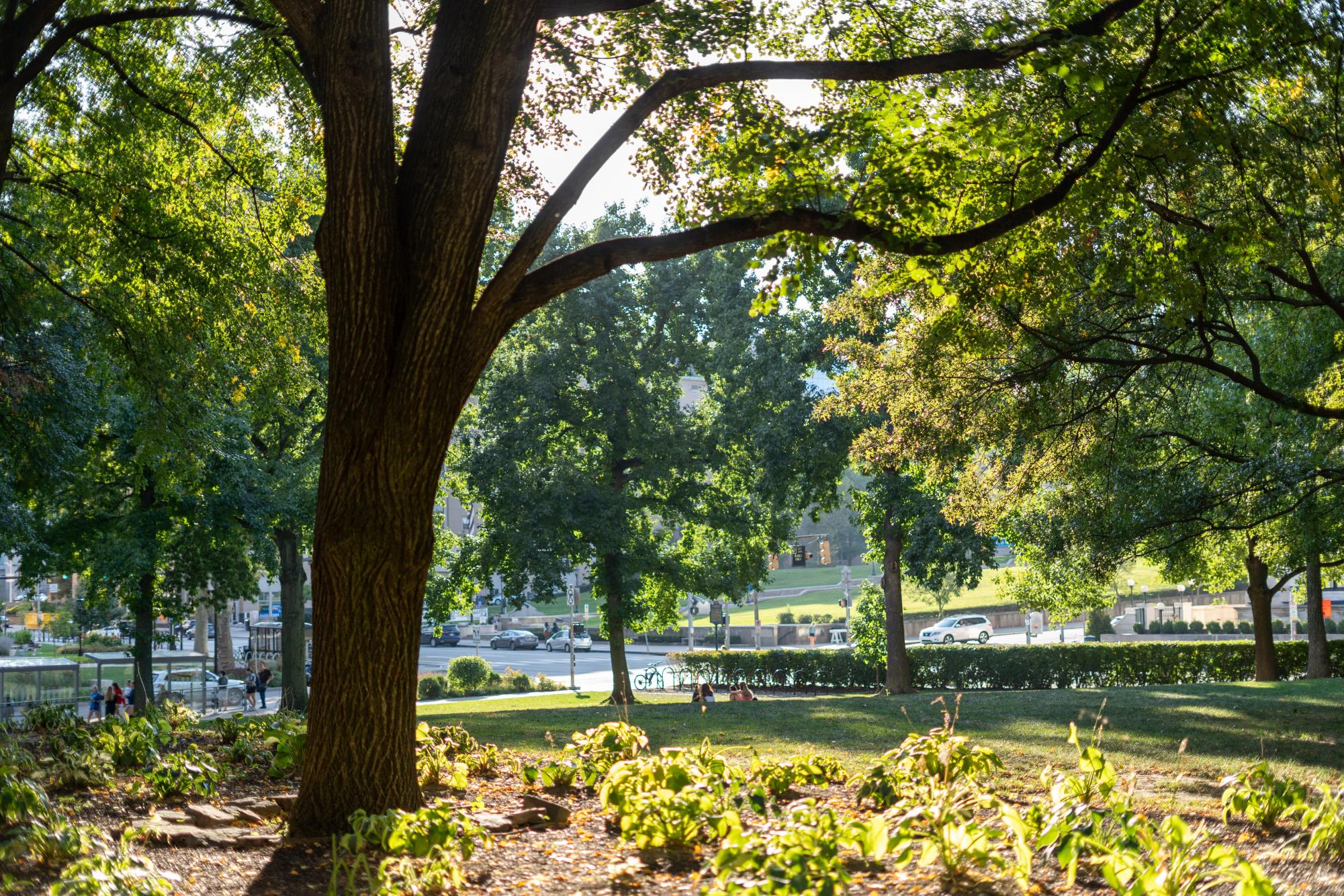Fall foliage in Western PA not impacted by summer heat, Pennsylvania Department of Forestry says


Trees on the Cathedral lawn.
Meena Rajesh, a sophomore marketing and analytics major, said she feels the leaves are arriving a little later than normal this year.
“I’ve definitely noticed it is a bit greener than it usually is, but I think in probably the next coming weeks, it’ll start to look like fall as we remember it,” Rajesh said.
Fall foliage across Pennsylvania is influenced by a number of factors, specifically the summer heat and humidity. One misconception is that the heat will negatively impact the color change. There are many differences across the variety of species, but trees and their leaves are resilient across the board.
Ryan Reed, a natural resource program specialist at the Pennsylvania Department of Forestry, described abscission, the process of leaves separating from the stem of the tree and falling to the ground every year, as “very interesting,” explaining that deciduous trees store enough water throughout the year to survive the hot and dry summer.
“The dryness won’t affect the color because the truth is, the trees have gotten enough water. The leaves are actually a liability because the trees lose water if they don’t shed their leaves,” Reed said.
Some other factors that can delay or induce a color change include weather and varying amounts of daylight. As the nights become longer, the leaves will receive less sunlight which will cause them to fall. The timing and opacity of color are also distinct for each species of tree.
Pennsylvania is home to over 150 species of trees, shrubs and vines that change color with the seasons, according to Reed.
“In Pennsylvania, some of the species where we see vivid colors are maples, such as the sugar maple and red maple. Those are top stand outs,” Reed said. “Our black cherries in Pennsylvania are world-renowned, and their color can last for up to six weeks, and Sassafras trees produce the most vivid orange you can find.”
According to the 2023 reports from the Department of Conservation and Natural Resources, the leaves in Allegheny County began to change during week two of the fall season and reached their best color during the fourth week of the fall season.
2024 was the hottest summer on record, and fall so far in Pennsylvania has gone through many warm periods. Reed said he feels the foliage forecast is not going to be greatly affected by the summer temperatures. For instance, a warm period in the fall can also trigger the leaves to change because the trees will lose water, but the trees will still retain enough to survive.
“Foresters in the field would argue that the dry conditions would make the colors more vibrant because dry conditions will push the leaves into a color change,” Reed said. “There are also quite a few species that will begin the color change with an early shed, which is often the case with cherries and birches.”
Reed said as Pennsylvania’s climate shifts and becomes warmer, southern species of trees such as oaks and hickories will be dominant.
“I don’t think there’s anyone out there who doesn’t enjoy fall foliage, and if there is a threat to this national treasure, people would want to know that,” Reed said. “Eventually, the species composition will shift, but Pennsylvania will always be a state with the ability to grow a forest, and we want people to appreciate the forests the way we do, and we want advocates to protect this natural treasure.”
Reed said that the “yoyo effect” between dry and wet seasons each year is part of a bigger trend.
“In the last few years, we have been noticing more deviations from the norm, with the onset of fall foliage trending later with more wild swings in extremes,” Reed said. “There was one year where people were writing in saying the leaves went from green to brown to gone overnight due to an extremely wet season”
Rajesh said she prefers Pittsburgh fall to Philadelphia because she feels the change in seasons is a more gradual transition in the Western part of the state. She also said she thinks being so close to nature helps students feel less “boxed in.”
“I really enjoy Pittsburgh fall, because I feel like outside of Philly, it’s very hot for a while, and then there’s a week where it’s kind of mild, and then immediately after that, it gets very cold, so there’s not as much of an in-between,” Rajesh said.
Katie Kubay, a first-year finance and marketing major, thinks having so many trees in close proximity to campus is a “great thing Pitt has to offer.”
“It’s really nice to be able to reconnect with nature after spending all day in the library doing work on your computer,” Kubay said. “I’m from Pittsburgh, so I’m used to all the lovely fall foliage, and I’m excited to go hiking and look at leaves.”
Recent Posts
Therese Pitman: Giving back to Pitt’s student-athletes with equality
Pitman is Pitt’s Director of Student Athlete Development where she helps student-athletes navigate their career…
Pitt speech and debate team heads to nationals
The William Pitt Debating Union, Pitt’s speech and debate team, sends students to both in-person…
Visuals: A Year in Review
The visuals desk had an interesting year. In the midst of the 2024 Presidential Election,…
De-stress events across campus offer students a break from studying
During finals week, departments across campus are offering wellness events to help students manage stress…
Pitt students share their summer plans
After a long and strenuous academic year, many students are excited to take a break.…
Column | Collaboration and connection make us better — yes, even in journalism
Today is the last day I will ever do this, and despite the amount of…

